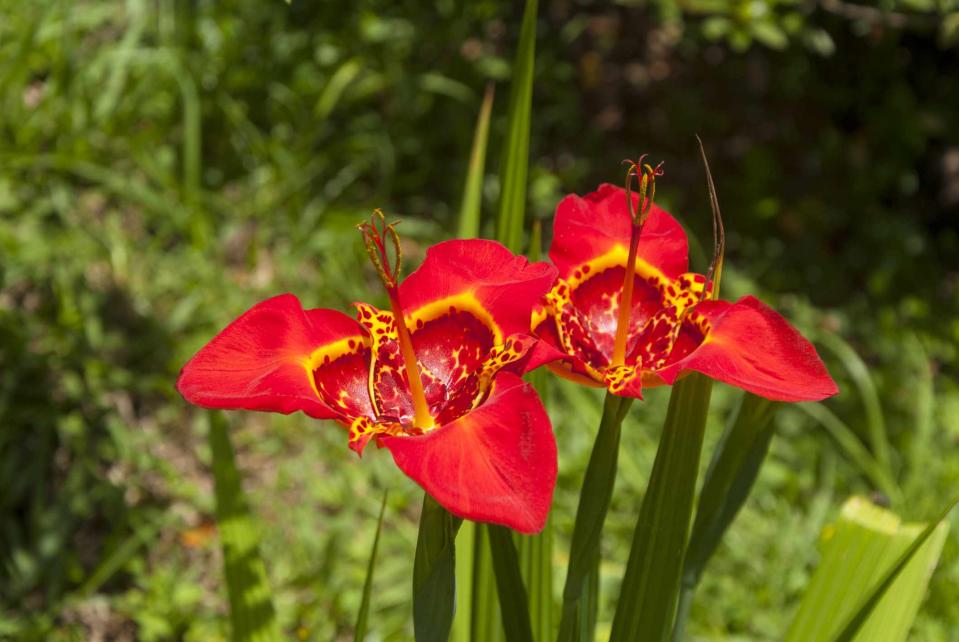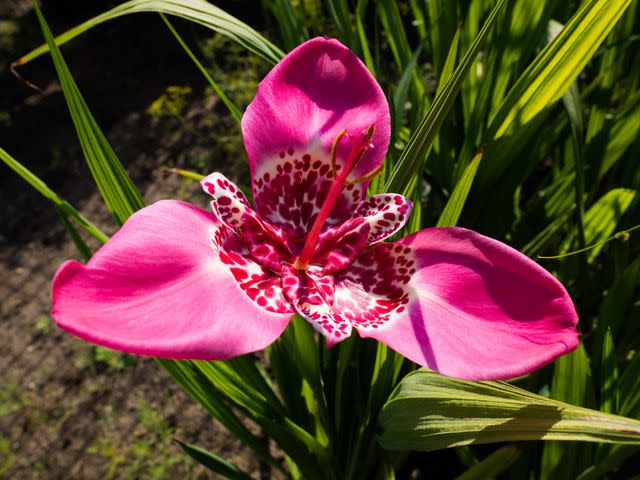How to Grow and Care for Tiger Flower
Summer-Blooming Bulbs That Add Vibrant Colors to Your Yard or Patio

ByronOrtizA / Getty Images
Reviewed by Julie Thompson-Adolf
Of more than 50 species in the Tigridia genus of bulb-forming plants, by far the most well-known and widely grown is Tigridia pavonia, more commonly known as the tiger flower. With sword-like foliage similar to that of gladiolus, and flowers that bloom for just a single day like daylily, tiger flowers come in vivid pinks, reds, yellows, and oranges. The sparse foliage of the tiger flower is often mistaken for that of gladiolus, and the two plants, both members of the iris family, have similar care requirements. Like gladiolus, tiger flowers are tender perennials whose bulbs must be lifted and stored for the winter in colder climates.
Tiger flowers are usually planted as bulbs in the spring. They grow quickly to flower in summer, with the foliage dying back in fall.
Common Name | Tiger flower, Mexican shellflower, peacock flower |
Botanical Name | Tigridia pavonia |
Family | Iridaceae |
Plant Type | Herbaceous, perennial |
Mature Size | 12–24 in. tall, 5 in. wide |
Sun Exposure | Full, partial |
Soil Type | Well-drained |
Soil pH | Acidic, neutral, alkaline |
Bloom Time | Summer |
Flower Color | Pink, red, yellow, white |
Hardiness Zones | 8–10 (USDA) |
Native Area | North America, Central America, South America |
Tiger Flower Care
Tiger flowers, despite their exotic appearance, are relatively easy to grow. Here are the main care requirements:
Select a sunny location with well-drained soil.
Plant the bulbs after all danger of spring frost has passed and the soil has a temperature of at least 55 degrees F. For best impact, plant them 4 to 5 inches apart and 2 to 3 inches deep in groups of three to seven bulbs.
Keep the soil well-watered until they flower.
Fertilize them monthly until midsummer.
Let the foliage die back naturally and don’t remove it until fall cleanup.

Light
These plants are sun lovers, and you should position them so they get plenty of it—at least six hours each day. Although they tolerate some shade in hot regions, they may not bloom as prolifically.
Soil
Tiger flowers require excellent drainage and do poorly in standing water. Sandy or loamy soil is perfect. The plant grows in slightly acidic to slightly alkaline soil with a pH between 6.1 and 7.8. Excessively wet soil in the winter sometimes causes bulb rot.
Water
While your tiger flowers are establishing, you'll want to keep the soil consistently moist. Once mature, they'll still appreciate regular watering, but they're relatively drought-tolerant plants and cope with drier conditions.
Temperature and Humidity
Growing tiger flowers as perennials that come back every year requires a climate with mild winters. Below USDA hardiness zone 8, they must be planted as annuals or dug up and stored each winter. They don't cope with freezing temperatures but can readily handle intense heat and humidity. In cool climates, growing them in containers is a good option as it easily lets you move them to a sheltered location over the winter.
Fertilizer
From spring to midsummer, fertilize the plants a couple of times with a slow-release bulb fertilizer or monthly with a diluted liquid flower fertilizer.
Types of Tiger Flower
There are several tiger flower cultivars. The bulbs are often sold in bulk mixtures of unnamed varieties in a mix of colors, which is an economical way for mass plantings. Notable varieties include:
'Alba': a white variety with centers speckled with red and yellow.
'Aurea': a bright yellow cultivar with a red-spotted center cup.
'Lilacea': a vibrant purple variety with darker red speckles in the center cup.
Pruning
Do not trim the foliage until it dies and turns brown in the fall, well after the flowers have faded. The continued growth of the foliage is necessary to replenish the bulbs. Remove the foliage as part of your fall cleanup.
Propagating Tiger Flower
Even if you don't want more tiger flowers from your existing plants, it's a good idea to dig up and divide them every three years or so to keep the clump confined and robust. Here's how:
In the fall, use a fork or trowel to carefully dig up the bulbs. Break off the stems as you remove the bulbs from the ground.
Break off the offset bulbs that are attached to the parent. Discard the parent bulbs if they are rotted or desiccated.
Place the bulbs in a paper bag with a handful of sand, and store the bulbs over the winter in a cool, dry place. Plant them in the spring.
How to Grow Tiger Flower From Seed
Tiger flowers grow unusually fast from seeds when compared to other bulb species, some of which take years to develop bulbous roots that support flowers. With tiger flowers, your seeds may produce blooms in the first year.
Fill seed trays or small pots with commercial potting mix.
Sow the seeds about 1 inch apart on the surface.
Moisten the potting mix by misting, then cover the containers with a clear plastic bag or another clear cover.
Place the container in a warm location, at least 65 degrees F, where there is plenty of light but not direct sunlight.
Keep the soil moist by periodic misting until the seeds sprout.
After they sprout, remove the plastic and continue growing until the plants are at least 3 inches tall. Harden off the seedlings and wait until outdoor soil temperatures have reached at least 55 degrees F before planting them outdoors.
Potting and Repotting Tiger Flower
As tiger flowers look best when planted in clusters, use a large container with a diameter of 10 to 12 inches (5-gallon capacity) or larger. Make sure the container has good drainage and fill it with commercial potting mix. Plant the bulbs about 5 inches apart, but leave at least 5 inches between the outer bulbs and the sides of the pot.
Potted tiger flowers will need more frequent watering and feeding, and they will likely need to be divided and repotted every year or two.
Overwintering
When planted within their accepted hardiness range, these plants require little in the way of winter protection. If you live in a colder zone, the bulbs can be dug up and stored for the winter, in much the same way as gladiolus bulbs are handled. Cold-region gardeners growing potted tiger flowers should move the pots to a sheltered location, such as a garage or shed, to spend the freezing winter months.
As the foliage dies back and turns brown in late fall or early winter, cut off the stems and leaves at ground level. Watering should be withheld over the winter months.
Common Pests & Plant Diseases
These plants are largely free of the pest and disease issues that affect other bulbs. Excessively wet soil in the winter sometimes causes bulb rot.
How to Get Tiger Flower to Bloom
Bloom Months
Tiger flower blooms between July and September.
How Long Does Tiger Flower Bloom?
While each flower only lasts one day, like a daylily, the multiple stems produce additional blooms for several weeks.
What Do Tiger Flowers Look and Smell Like?
The flowers, which come in a kaleidoscope of colors, are 3 to 6 inches in diameter with three large petals and three smaller ones around a center cup. It is the tiger pattern in the center that makes these flowers so attractive. The flowers do not have any particular scent.
How to Encourage More Blooms
Poor bloom or failure to bloom is almost always traced to shortcomings in basic needs: not enough sun, not enough fertilizer, or not enough (or too much) water. Following basic care needs is normally enough to keep these plants blooming.
An overgrown clump may not bloom as readily; it will benefit from digging up and splitting the bulbs for replanting.
Caring for Tiger Flower After It Blooms
After-bloom care is the hands-off approach. Leave the plants alone and let the foliage die back naturally.
Deadheading Tiger Flowers
Cutting the flowers back as they begin to fade, about 6 inches down the stalk, will stimulate the plant into additional blooms.
Frequently Asked Questions
What is the difference between tiger flower and tiger lily?
The two plants belong to different families. Tiger lily is a true lily from the Liliaceae family, while tiger flower is closely related to iris. Both are summer bloomers, but tiger lily is hardy as far north as zone 3, while tiger flower is a warm-weather perennial. Both plants have flowers with distinctive speckled throats, but the blossoms on tiger flower are fairly wide open and last for only a day, while the blooms on tiger lily have a distinctive trumpet shape and remain open for up to a week.
Where should I plant tiger flowers?
Because the foliage is sparse, tiger flowers are best planted where other plants will shield the base, such as in the middle of the border or behind lower-growing foreground plants. Plant it in groups or clusters among low-growing perennials that help support the delicate stems. Tiger flowers also look fantastic grown in containers on sunny patios.
Where does the tiger flower come from?
Tiger flowers are native to Mexico, Guatemala, San Salvador, and Honduras and have naturalized in Peru and Ecuador.
Read the original article on The Spruce.

